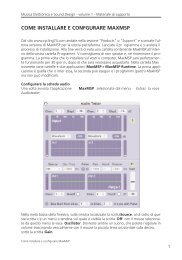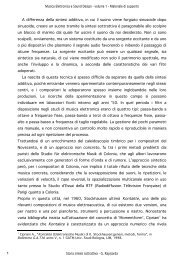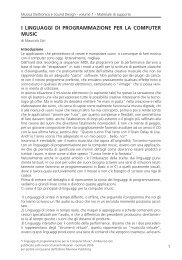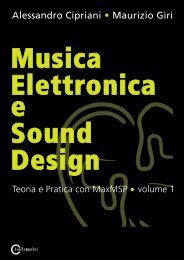programming with max/msp - Virtual Sound
programming with max/msp - Virtual Sound
programming with max/msp - Virtual Sound
You also want an ePaper? Increase the reach of your titles
YUMPU automatically turns print PDFs into web optimized ePapers that Google loves.
Electronic Music and <strong>Sound</strong> Design - Foreword<br />
FOREWORD<br />
by David Zicarelli<br />
It might seem odd to you, but many years ago, I spent a lot of time learning<br />
about making sound <strong>with</strong> a computer by reading books and articles while trying<br />
to imagine what the synthesis techniques being described would actually<br />
sound like. While I suppose my imagination might have been stimulated by this<br />
practice, I am happy that real-time synthesis has progressed to the point where<br />
you no longer have to be deprived of the perceptual experience that is such an<br />
important part of learning the techniques of digital synthesis.<br />
Alessandro Cipriani and Maurizio Giri’s book is one of the first courses on<br />
electronic sound that explicitly integrates perception, theory, and practice using<br />
examples of real-time sound synthesis you can manipulate and experience<br />
for yourself. In my view, the manipulation aspect of learning about sound is<br />
critically important. It helps lead you to what Joel Chadabe terms “predictive<br />
knowledge” -- the ability to intuit what will happen to a sound before you take<br />
an action to change it. We all have some level of predictive knowledge. For<br />
example, most of us know that by turning a volume knob clockwise, the sound<br />
coming from our amplifier will get louder. Once we enter the realm of digital<br />
sound synthesis, things quickly get more complicated than a volume knob, and<br />
we need the first-hand experience of manipulation and perception in order to<br />
deepen our predictive knowledge.<br />
However, to educate ourselves fully about digitally produced sound, we need<br />
more than predictive knowledge. We need to know why our manipulations<br />
make the perceptual changes we experience. This theoretical knowledge<br />
reinforces our intuitive experiential knowledge, and at the same time, our<br />
experience gives perceptual meaning to theoretical explanations.<br />
In my opinion, Cipriani and Giri have done a masterful job of allowing<br />
experiential and theoretical knowledge to reinforce each other. This book will<br />
work either as a textbook or as a vehicle for the independent learner. As a<br />
bonus, the book includes a thorough introduction to digital signal processing<br />
<strong>with</strong> Max/MSP and serves as a wonderful introduction to the <strong>programming</strong><br />
concepts in that software.<br />
As you will see, the theoretical chapters are the “T” chapters, while practical<br />
and experiential knowledge is imparted by the “P” chapters. These chapters<br />
alternate, in the form of a ladder, refining the concepts at ever higher levels of<br />
sophistication.<br />
I hope you will take advantage of the excellent Max/MSP examples the authors<br />
have created. They are simultaneously fun and enlightening, and they sound<br />
good enough to use on stage. They are also worth examining as models for<br />
your own Max/MSP patches, or for extending in new ways. But a few minutes<br />
of messing around <strong>with</strong> the examples is not the same thing as studying the<br />
from “Electronic Music and <strong>Sound</strong> Design” Vol. 1 by Alessandro Cipriani and Maurizio Giri<br />
© ConTempoNet 2010 - All rights reserved<br />
VII







